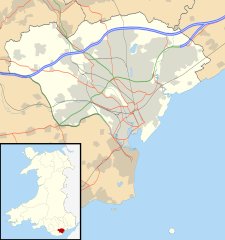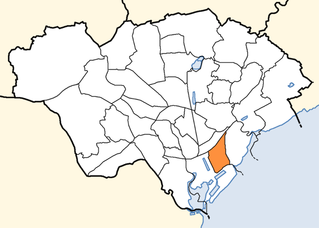
Splott is a district and community in the south of the city of Cardiff, capital of Wales, just east of the city centre. It was built up in the late 19th century on the land of two farms of the same name: Upper Splott and Lower Splott Farms. Splott is characterised by its once vast steelworks and rows of tightly knit terraced houses. The suburb of Splott falls into the Splott electoral ward.
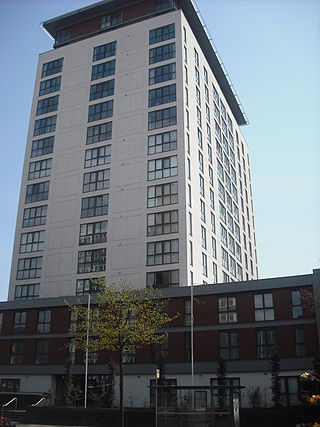
Adamsdown is an inner city area and community in the south of Cardiff, the capital city of Wales. Adamsdown is generally located between Newport Road, to the north and the mainline railway to the south. The area includes Cardiff Prison, Cardiff Magistrates' Court, Cardiff Royal Infirmary, a University of South Wales campus, and many streets of residential housing. There are two primary schools in the area Adamsdown Primary School and Tredegarville Primary School.

The Countess of Chester Hospital is the main NHS hospital for the English city of Chester and the surrounding area. It currently has 625 beds, general medical departments and a 24-hour accident and emergency unit. It is managed by the Countess of Chester Hospital NHS Foundation Trust, one of the first Foundation Trusts in the UK, formed in 2004. Cardiac rehabilitation services at the hospital are provided by Cheshire and Wirral Partnership NHS Foundation Trust.

The Leicester Royal Infirmary (LRI) is a National Health Service hospital in Leicester, England. It is located to the south-west of the city centre. It has an accident and emergency department and is managed by of the University Hospitals of Leicester NHS Trust.

Manchester Royal Infirmary (MRI) is a large NHS teaching hospital in Chorlton-on-Medlock, Manchester, England. Founded by Charles White in 1752 as part of the voluntary hospital movement of the 18th century, it is now a major regional and national medical centre. It is the largest hospital within Manchester University NHS Foundation Trust, and based on its Oxford Road Campus in South Manchester where it shares a site with the Royal Manchester Children's Hospital, Manchester Royal Eye Hospital and Saint Mary's Hospital as well as several other educational and research facilities. The Hospital is also a key site for medical educational within Manchester, serving as a main teaching hospital for School of Medical Sciences, University of Manchester.

University Hospital of Wales (UHW), also known as the Heath Hospital, is a 1,080-bed hospital in the Heath district of Cardiff, Wales. It is a teaching hospital of Cardiff University School of Medicine. Construction started in 1963, and the official opening took place in 1971. It was Europe's first fully integrated hospital and medical school, at a cost of £22 million. It is the third largest university hospital in the UK, and the largest hospital in Wales. The hospital was previously managed by Cardiff & Vale NHS Trust. In 2009 the Trust was dissolved and the hospital is now managed by Cardiff and Vale University Health Board.

Southmead Hospital is a large public National Health Service hospital, situated in the area of Southmead, though in Horfield ward, in the northern suburbs of Bristol, England. It is part of the North Bristol NHS Trust. The 800-bed Brunel Building opened in May 2014, to provide services, which transferred from Frenchay Hospital in advance of its closure. The hospital site covers 60 acres (24 ha).

The Bristol Royal Infirmary, also known as the BRI, is a large teaching hospital in the centre of Bristol, England. It has links with the nearby University of Bristol and the Faculty of Health and Social Care at the University of the West of England, also in Bristol.

The Royal United Hospital (RUH) is a major acute-care hospital in the Weston suburb of Bath, England, which lies approximately 1.5 miles (2.4 km) west of the city centre. The hospital has 565 beds and occupies a 52 acres (21 ha) site. It is the area's major accident and emergency hospital, with a helicopter landing point on the adjacent Lansdown Cricket Club field. The hospital is operated by the Royal United Hospitals Bath NHS Foundation Trust.

The Royal Gwent Hospital is a local general hospital in the city of Newport. It is managed by the Aneurin Bevan University Health Board. Since 2020, the hospital no longer has a full Emergency Department, and redirects those with a serious illness or injury to call 999 or go to attend the Grange University Hospital in Cwmbran. The Royal Gwent hospital has a 24-hour Minor Injuries Unit.
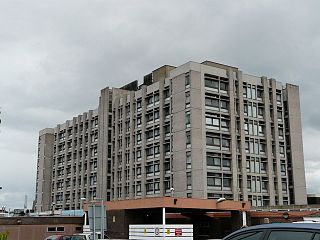
Doncaster Royal Infirmary is a district general hospital of 800 beds, located in Doncaster, South Yorkshire, England. It is managed by Doncaster and Bassetlaw Teaching Hospitals NHS Foundation Trust.

A dispensary is an office in a school, hospital, industrial plant, or other organization that dispenses medications, medical supplies, and in some cases even medical and dental treatment. In a traditional dispensary set-up, a pharmacist dispenses medication per the prescription or order form. The English term originated from the medieval Latin noun dispensaria and is cognate with the Latin verb dispensare, 'to distribute'.

Cardiff and Vale University Health Board is the local health board of NHS Wales for Cardiff and Vale of Glamorgan, in the south-east of Wales. Formed on 1 October 2009 through the amalgamation of three NHS organisations in the Cardiff and Vale of Glamorgan area. The three organisations amalgamated were: Cardiff and Vale NHS Trust, employing 12,000 staff and previously responsibility for hospital services in the Cardiff and Vale of Glamorgan area; Cardiff Local Health Board; and Vale of Glamorgan Local Health Board both responsible for GP, Dental, Optical and pharmacy services. The headquarters of the Board is in the University Hospital of Wales, in Cardiff. Cardiff and Vale University Health Board is the operational name of Cardiff and Vale Local Health Board.

Whitchurch Hospital was a psychiatric hospital in Whitchurch, an area in the north of Cardiff. It was managed by the Cardiff and Vale University Health Board. The hospital remains a grade II listed building. Its grounds are separately listed, also at Grade II, on the Cadw/ICOMOS Register of Parks and Gardens of Special Historic Interest in Wales.

Newport Road is a 4.7 mi (7.5 km) road leading east from the centre of Cardiff, Wales, towards Newport, until it joins the A48 at St Mellons.
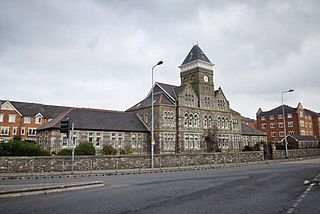
St David's Hospital is a health facility in Canton, Cardiff, Wales. It is managed by the Cardiff and Vale University Health Board. The original main block is a Grade II listed building.

The Royal Hamadryad Hospital was a seamen's hospital and later a psychiatric hospital in the docklands area of Cardiff, Wales. It had replaced a hospital ship, the former HMS Hamadryad, in 1905. After it closed in 2002 the site was redeveloped for residential use.

The Bolton Royal Infirmary was an acute general hospital in Chorley Street, Bolton, Greater Manchester, England.
Stirling Health and Care Village is a health and care facility at Livilands Gate in Stirling, Scotland. It is managed by NHS Forth Valley as well as Stirling and Clackmannanshire's HSCP. It was formerly known as Stirling Community Hospital.

